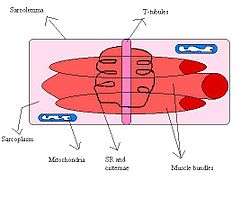Sarcoplasm
| Sarcoplasm | |
|---|---|
 Muscle system | |
| Details | |
| Identifiers | |
| Latin | sarcoplasma |
| Code | TH H2.00.05.0.00004 |
Sarcoplasm is the cytoplasm of a myocyte (muscle fiber). It is comparable to the cytoplasm of other cells, but it contains unusually large amounts of glycosomes (granules of stored glycogen) and significant amounts of myoglobin, an oxygen-binding protein. The calcium ion concentration in sarcoplasma is also a special element of the muscle fiber; it is the means by which the muscle contractions take place and are regulated.
It contains mostly myofibrils (which are composed of sarcomeres), but its contents are otherwise comparable to those of the cytoplasm of other cells. It has a Golgi apparatus near the nucleus, mitochondria just inside the cell membrane (sarcolemma), and a smooth endoplasmic reticulum (specialized for muscle function and called the sarcoplasmic reticulum).
The words sarcoplasm and myoplasm are not synonyms, despite that etymologically they seem like they ought to be. Whereas sarcoplasm is a type of cytoplasm, myoplasm is the entire contractile portion of muscle tissue.
External links